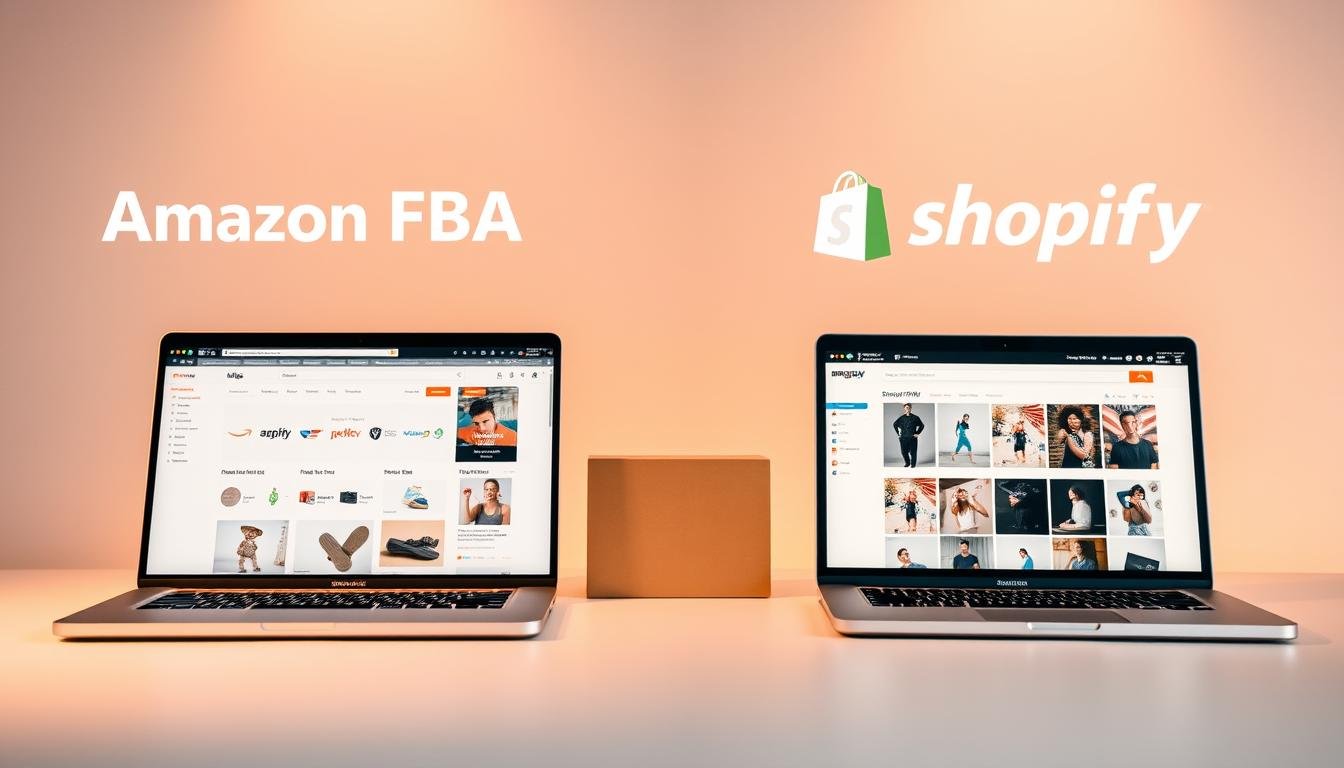Amazon FBA vs. Shopify: Which One Makes More Money?
You’re not alone in this dilemma. Many online entrepreneurs struggle to decide between two popular ecommerce platforms: one that offers a built-in customer base and another that provides customization and control.
The question remains: which platform will generate more revenue for your business? To answer this, we’ll explore the unique business models, fee structures, and customer acquisition strategies of both options.
By examining the pros and cons of each, you’ll be better equipped to make an informed decision about where to invest your time and resources.
Key Takeaways
- Understand the fee structures of both ecommerce platforms
- Learn how to leverage customer acquisition strategies
- Discover the profit potential of each platform
- Determine which platform aligns with your business goals
- Make an informed decision about your ecommerce venture
Understanding the E-commerce Landscape
In the modern e-commerce ecosystem, Amazon and Shopify have carved out distinct niches. As you navigate the online selling landscape, understanding the roles of these major platforms is crucial.
The e-commerce landscape has evolved dramatically, with Amazon and Shopify dominating different segments. Amazon, with its 2.5 billion monthly visits, accounts for 37.8% of all U.S. e-commerce sales, making it a significant marketplace for sellers. On the other hand, Shopify powers over 4.4 million businesses worldwide, generating more than $700 billion in sales for its merchants.
| Platform | Monthly Visits | E-commerce Share |
|---|---|---|
| Amazon | 2.5 Billion | 37.8% |
| Shopify | N/A | N/A |
Understanding the difference between marketplace platforms like Amazon, where you list products alongside competitors, and standalone store platforms like Shopify, where you build your own branded experience, is key to choosing the right ecommerce strategy for your audience and improving customer satisfaction.
By examining how different businesses leverage these platforms based on their unique needs and customer acquisition approaches, you can make an informed decision that suits your business goals.
What is Amazon FBA?
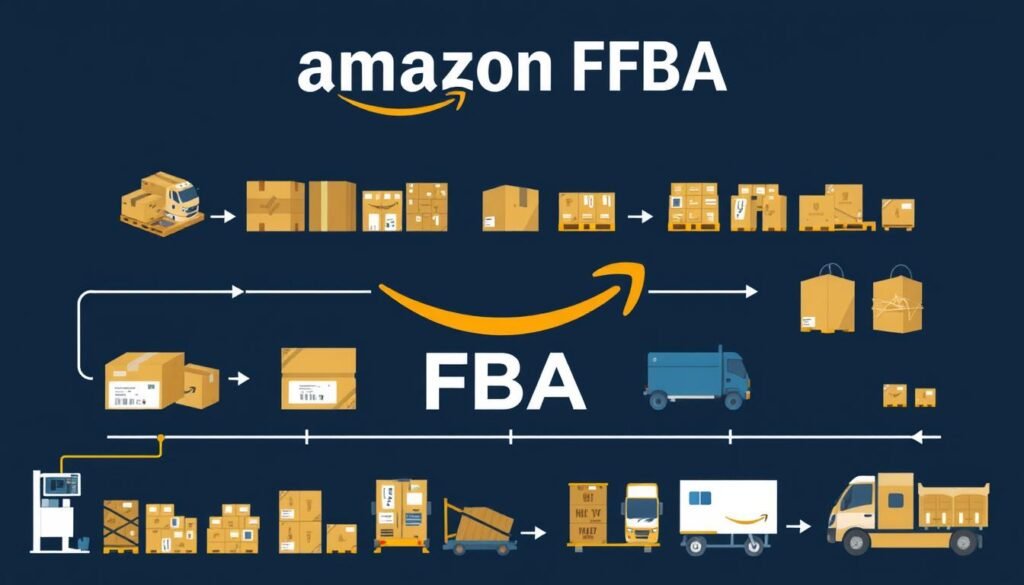
For many Amazon sellers, Amazon FBA is the key to unlocking a stress-free and scalable business model. Amazon FBA, or Fulfillment by Amazon, is a logistics and shipping service that allows you to store your products in Amazon’s warehouses, and they handle the packaging, shipping, and customer service.
By leveraging Amazon FBA, you can revolutionize how you handle logistics. You ship your products to Amazon’s fulfillment centers, where they take care of storage, packaging, and shipping. This creates a hands-off business model where Amazon handles customer service, returns, and refunds on your behalf.
The benefits of using Amazon FBA include gaining access to Prime shipping benefits, which can significantly increase your visibility and conversion rates. Many sellers choose Amazon FBA despite its costs because it minimizes their involvement in day-to-day operations, allowing them to focus on product sourcing and marketing.
Understanding how Amazon FBA works is crucial for any seller looking to maximize their sales potential on the platform. By comparing Amazon FBA to other Amazon selling programs and even to Amazon Shopify integration, you can make an informed decision about which fulfillment service is right for your business.
What is Shopify?
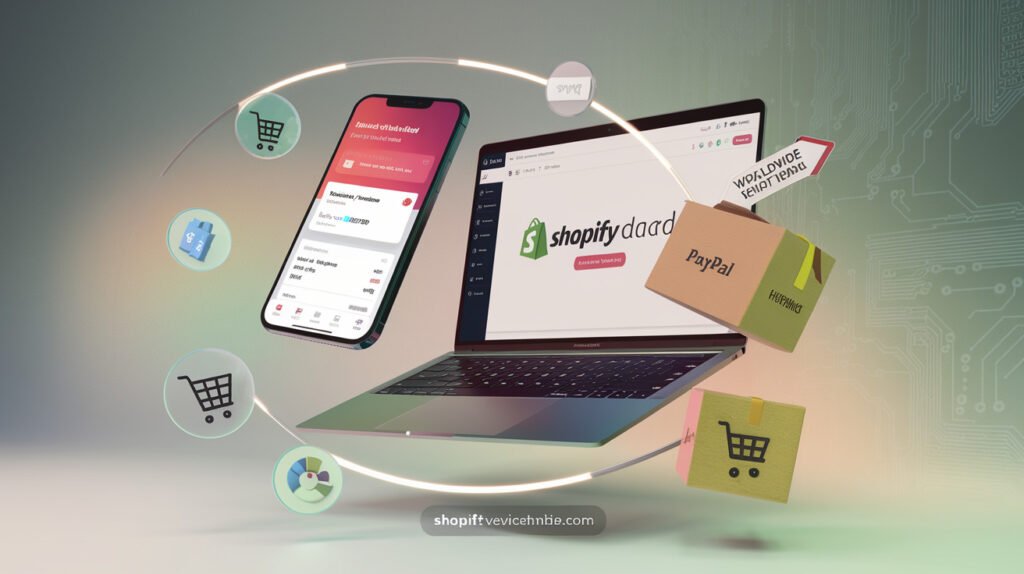
Shopify stands out as a comprehensive e-commerce solution, empowering businesses to establish a strong online presence. With Shopify, you can build and customize your own online store without needing extensive technical knowledge.
As a robust e-commerce platform, Shopify provides all the essential tools for running an online business, from inventory management to payment processing, marketing features, and analytics. This allows you to have complete control over your customer relationships and build a database of customer information for remarketing purposes.
Some key benefits of using Shopify include:
- Shopify’s theme-based design system allows you to create a branded shopping experience that reflects your unique business identity.
- The platform’s app ecosystem extends its functionality, enabling you to add features like email marketing, loyalty programs, and advanced inventory management.
- Shopify offers various payment processing options, including Shopify Payments, PayPal, and Apple Pay, although third-party payment processors may come with extra fees.
- Features like abandoned cart recovery help boost your conversion rates by nudging hesitant buyers back to the checkout page.
By choosing Shopify, you gain the flexibility to manage your online business effectively. For a comparison of Shopify with other e-commerce solutions like Amazon, visit our detailed comparison page.
Amazon FBA vs. Shopify: Which One Makes More Money?
The profitability of Amazon FBA versus Shopify depends on several factors, including your business model and pricing strategy. When considering which platform makes more money, it’s essential to understand that revenue potential varies significantly based on your specific business approach.
Amazon FBA typically generates faster initial sales due to its vast, built-in audience. For instance, Amazon Prime members spend an average of $1,400 annually, while non-Prime members spend around $600. This existing customer base can significantly boost your sales volume. On the other hand, Shopify stores often achieve higher profit margins per sale, with an average order value (AOV) of $85. However, achieving consistent sales on Shopify requires more upfront effort to drive traffic to your store.Key factors influencing profitabilityon both platforms include product pricing flexibility, fee structures, and customer acquisition costs. Your control over pricing directly impacts your ability to maintain healthy profit margins. For example, on Amazon, you’re subject to the platform’s pricing policies and competitive landscape, whereas on Shopify, you have more flexibility to adjust your pricing strategy.Realistic revenue scenariosfor both platforms depend on product categories and price points. By understanding these dynamics, you can better visualize your potential earnings on either platform. According to experts, “The key to success on either platform lies in understanding your business model and adapting your strategy accordingly.”
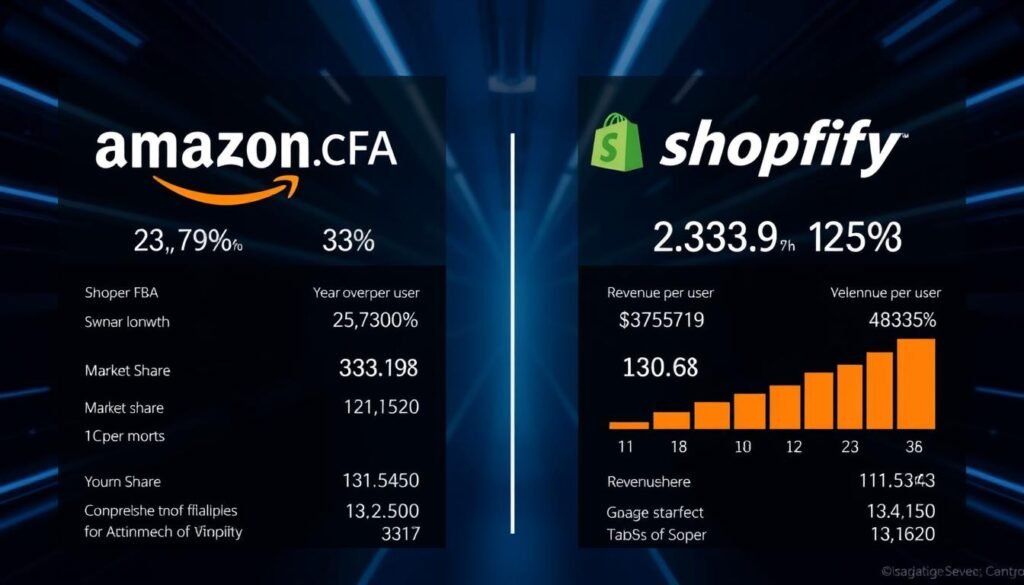
Ultimately, whether Amazon FBA or Shopify makes more money for you depends on your business model, product type, and marketing strategy. By carefully considering these factors, you can make an informed decision that aligns with your revenue goals.
Fee Structures Compared
To determine which e-commerce platform is more profitable, it’s essential to compare their fee structures. Amazon FBA and Shopify have different pricing models that can significantly impact your business’s profitability.
Amazon FBA’s Complex Fee System: Amazon charges you for various services, including referral fees ranging from 8% to 15% per sale, FBA fees for storage, picking, packing, and shipping. Additionally, there’s a monthly subscription fee of $39.99 for Professional sellers. You might also incur long-term storage fees if your inventory remains unsold for too long.
Shopify’s Straightforward Pricing: In contrast, Shopify’s pricing model is more predictable. You’ll pay a monthly subscription fee ranging from $29 to $299, depending on your plan. If you don’t use Shopify Payments, you’ll also incur transaction fees. Moreover, you might opt for premium themes, apps, and marketing tools, which add to your overall costs.
Understanding these fee structures is crucial for calculating your true profit margins. By comparing the costs associated with Amazon FBA and Shopify, you can determine which platform makes more financial sense for your business, especially when selling products at different price points.
For instance, products with higher price points might be more profitable on Shopify due to lower fees, while lower-priced items might benefit from Amazon’s vast customer base despite higher referral fees. Your monthly costs will vary based on the platform’s pricing model and your sales volume.
Brand Control and Customer Experience
E-commerce platforms differ significantly in how they allow you to manage your brand and customer experience. With Shopify, you have full control over your online store, including its design, layout, and branding. This means you can create a distinctive shopping experience that builds brand loyalty.
In contrast, Amazon is a bustling marketplace where you’re one of many sellers. While Amazon takes care of payments, fulfillment, and customer service, you relinquish control over customer interactions and data. This limits your ability to differentiate your business beyond product and price.

The table below summarizes the key differences in brand control and customer experience between Shopify and Amazon FBA:
| Platform | Brand Control | Customer Experience |
|---|---|---|
| Shopify | You have full control over your store’s design and branding. | You can create a tailored shopping experience. |
| Amazon FBA | Limited control due to standardized shopping experience. | Amazon handles customer service and fulfillment. |
Ultimately, the choice between Amazon FBA and Shopify depends on how much control you want over your brand and customer experience. By understanding these differences, you can make an informed decision that aligns with your business goals.
Traffic and Marketing Considerations
When it comes to selling on Amazon FBA or Shopify, understanding the nuances of traffic and marketing is crucial for your business’s success.
Amazon provides immediate access to its massive customer base and built-in traffic. However, you must master Amazon’s internal SEO system, which prioritizes sales velocity, reviews, and strategic keyword usage to increase your product’s visibility and sales.

In contrast, Shopify requires you to build your own traffic through external marketing channels like Google SEO, social media, and email marketing. This approach gives you more control over your audience but demands a more significant upfront effort in creating and executing a marketing strategy.
- Understand the costs associated with customer acquisition on both platforms.
- Consider how different traffic sources affect conversion rates and customer loyalty.
- Evaluate your marketing expertise and budget before choosing a platform.
Ultimately, your decision between Amazon FBA and Shopify should be influenced by your ability to drive traffic and effectively market your products to your target audience and grow your customer base.
Fulfillment and Logistics
When it comes to getting your products to customers, Amazon FBA and Shopify take distinctly different approaches to fulfillment and logistics. Amazon FBA is renowned for its fast and efficient shipping, with products often arriving in two days or less, thanks to its extensive logistics network.
However, this speed comes at a cost, including storage fees that can be substantial, especially for large or bulky items. On the other hand, Shopify puts you in control of your fulfillment and logistics, allowing you to choose your carriers, shipping rates, and packaging. This flexibility can be beneficial for businesses with specific needs or those looking to maintain a premium brand image through customized packaging.
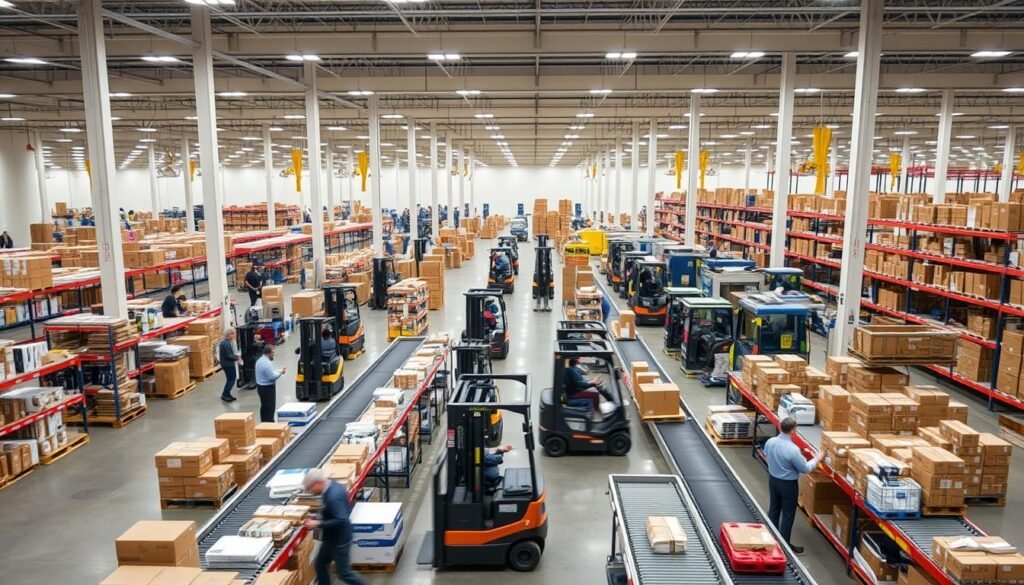
The contrast between Amazon FBA’s hands-off, comprehensive fulfillment service and Shopify’s DIY approach has significant implications for your operational workload and time management. While Amazon handles storage, picking, packing, shipping, and returns processing, Shopify requires you to manage these aspects either in-house or through third-party logistics providers.
Understanding the true costs of fulfillment on both platforms, including hidden expenses like return processing and inventory storage, is crucial for making an informed decision that aligns with your business needs and budget.
Product Types and Market Fit
Your product type plays a significant role in determining whether Amazon FBA or Shopify is more suitable for your business. The nature of your products can significantly influence your sales and overall success on either platform.
Commodity products, such as phone chargers and household essentials, tend to perform exceptionally well on Amazon due to its vast customer base and search-driven shopping environment. On the other hand, niche and customizable products often find more success on Shopify, where you can create a premium brand experience and justify higher price points.
- Commodity products with established demand typically excel on Amazon.
- Unique and luxury products benefit from Shopify’s ability to craft an immersive brand story.
- Product characteristics like price point, uniqueness, and purchase frequency align differently with each platform’s strengths.
When evaluating your product line, consider whether your items are best suited for Amazon’s marketplace or Shopify’s branded store approach. Understanding which marketplace or platform is most conducive to your sellers and products is crucial for maximizing your sales potential.
Using Amazon and Shopify Together

By integrating Amazon FBA and Shopify, you can leverage the strengths of both platforms, potentially increasing your overall sales by an average of 20% according to merchant data. This hybrid approach allows you to use Shopify as your brand’s home base while utilizing Amazon FBA as an additional sales channel.
Many successful sellers leverage both platforms simultaneously, creating a hybrid approach that maximizes the strengths of each while minimizing their individual weaknesses. You’ll learn how to use inventory synchronization tools to prevent overselling and streamline order management across both channels, effectively managing your inventory.
To make the most of this integration, you’ll need to understand the additional time and resource commitments required to manage both platforms effectively, including separate marketing strategies and inventory allocation. For more information on managing your e-commerce business, you can explore other resources such as beginner-friendly side hustle ideas.
By using data from each platform, you can inform your overall business strategy, leveraging Amazon’s market research capabilities alongside Shopify’s detailed customer insights to optimize your online store. This integrated approach enables you to maintain consistent pricing and branding across both channels while adapting to the unique requirements and customer expectations of each platform.
Conclusion: Making Your Choice
The decision between Amazon FBA and Shopify hinges on your business model, customer needs, and long-term vision. As you evaluate these platforms, consider your priorities: do you value immediate sales and simplified operations, or brand building and higher profit margins?
Your choice should align with your specific business goals, resources, and expertise. Assess your product type, target customer, available time, technical skills, and marketing budget to determine the best fit. Many successful entrepreneurs start with one platform and expand to the other as their ecommerce business grows.
Consider your personal preferences as a business owner, including the level of control you desire and how hands-on you want to be. This self-assessment will guide your decision between Amazon FBA and Shopify, ultimately shaping your business success. By understanding your customer and choosing the right platform, you’ll be well on your way to establishing a thriving ecommerce business on Amazon, Shopify, or both.
Evaluating your options carefully and planning for the future will help you make an informed decision, leveraging the strengths of either Amazon FBA, Shopify, or a combination of both in your amazon shopify strategy.
FAQ
What are the main differences in fees between selling on Amazon and using Shopify?
Can I have full control over my brand and customer experience on both platforms?
How do I drive traffic to my online store on Shopify?
What are the benefits of using Amazon’s fulfillment service?
Can I sell on both Amazon and Shopify simultaneously?
How do I manage my inventory across multiple sales channels?
What kind of customer data do I have access to on Amazon and Shopify?
How do I optimize my product listings for better sales on Amazon?
editor's pick
latest video
news via inbox
Nulla turp dis cursus. Integer liberos euismod pretium faucibua

